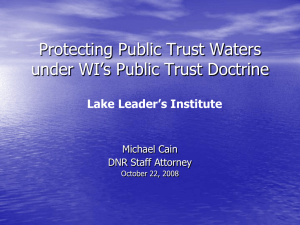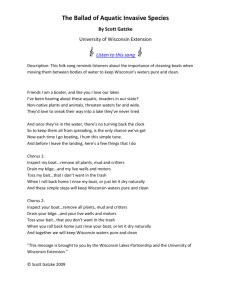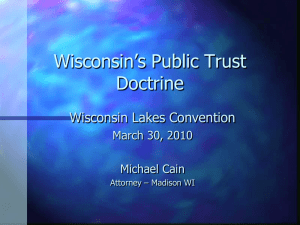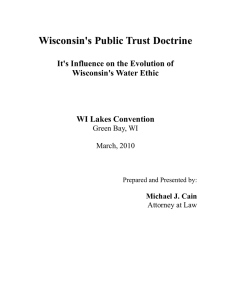Roman Law, Duck Hunting and Downtown Condos: The Many Faces
advertisement
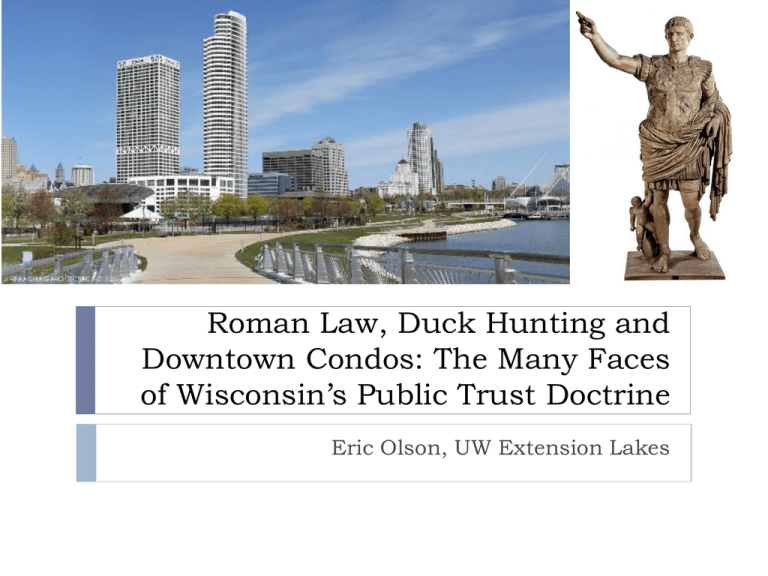
Roman Law, Duck Hunting and Downtown Condos: The Many Faces of Wisconsin’s Public Trust Doctrine Eric Olson, UW Extension Lakes Why do you need to know this? Public Trust Doctrine (PTD) establishes sideboards for a wide range of activities in Wisconsin, from outdoor recreation to land development to groundwater use These sideboards are rooted deeply and strongly in the State Constitution- the PTD is a force, not a fad At the same time, the PTD is not set in stone- it evolves The PTD gives us a lens for understanding natural resource conflicts and communicating to the public why government and courts behave the way they do Deep Roots of Public Trust Doctrine Ancient Roman law held seashores open to all Magna Carta (1215) limited people’s rights to interfere with waterways Northwest Ordinance (1787) Wisconsin Constitution Article IX Section I (1848) Deep Roots of Public Trust Doctrine “navigable waters leading into the Mississippi and St. Lawrence, and the carrying places between the same, shall be common highways and forever free….” These waters are OUR waters… STRONG Roots of Public Trust Doctrine Sen. Paul Hustings (1866-1917) Authored Water Power Acts governing dams in WI Diana Shooting Club v. Husting (1914) expanded public rights to include recreation Elected to US Senate same year Killed while duck hunting on the Horicon in 1917 Diana Shooting Club v. Husting (1914) "The wisdom of the policy which…steadfastly and carefully preserved to the people the full and free use of public waters, cannot be questioned. Nor should it be limited or curtailed by narrow constructions. It should be interpreted in the broad and beneficent spirit that gave rise to it in order that the people may fully enjoy the intended benefits. Navigable waters are public waters …They should be free to all for commerce, for travel, for recreation, and also for hunting, and fishing…." Additional Pre-WWII PTD Cases Doemel v. Jantz (1923): Riparian landowners granted special right and privileges (beach bums prohibited) City of Milwaukee v. State (1927) Legislature must both preserve and proactively protect waters, and resets the PTD as a fluid doctrine, not one cast in stone (or ice) Nekoosa-Edwards Paper Co. v. Railroad Commission (1930) expands protections to additional recreation like sailing, canoeing, and skating Post WWII Pace, scale, and nature of development expands due to population growth and industrialization Muench v. PSC (1951) clarifies “navigability” and expands public rights to include scenic beauty Hixon v. PSC (1966) recognizes cumulative impacts Just v. Marinette County (1972) extends PTD to areas beyond the ordinary high water mark Hixon v. PSC There are over 9,000 navigable lakes in Wisconsin covering an area of over 54,000 square miles. A little fill here and there may seem to be nothing to become excited about. But one fill, though comparatively inconsequential, may lead to another, and another, and before long a great body of water may be eaten away until it may no longer exist. Our navigable waters are a precious natural heritage; once gone, they disappear forever. Just v. Marinette County The active public trust duty of the state of Wisconsin in respect to navigable waters requires the state not only to promote navigation but also to protect and preserve those waters for fishing, recreation, and scenic beauty. . . To further this duty, the legislature may delegate authority to local units for the government, which the state did by requiring counties to pass shoreland zoning ordinances. Just v. Marinette County An owner of land has no absolute and unlimited right to change the essential natural character of his land so as to use it for a purpose for which it was unsuited in its natural state and which injures the rights of others. The exercise of the police power in zoning must be reasonable and we think it is not an unreasonable exercise of that power to prevent harm to public rights by limiting the use of private property to its natural uses. Extending the PTD to Groundwater Wisconsin v. Michels Pipeline (1974) recognizes the groundwater connection to lakes and rivers Lake Beulah Management District v. DNR (2011) reinforces state obligation to manage high cap. wells Lake Beulah v. DNR We conclude that… the DNR has the authority and general duty to consider whether a proposed high capacity well may harm waters of the state… We further hold that to comply with this general duty, the DNR must consider the environmental impact of a proposed high capacity well when presented with sufficient concrete, scientific evidence of potential harm to waters of the state.” Couture development project, Milwaukee Lakefront 2013 Wisconsin Act 140 Signed into law March 2014 Declares where the lake shoreline in Milwaukee is located and paves the way for private development on land that had been thought to be filled lake bed and thus subject to the PTD. Still could be subject to court challenge… Summary The Public Trust Doctrine helps us understand resource conflicts over water and development PTD also explains recreation patterns: beach privacy, trout fishing access, even why we don’t have stickers for boats like we do for cars, ATV, and snowmobiles To guard its rights to water, the public should understand what the Public Trust Doctrine is and what their role is in ensuring its vitality Additional Resources “Champions of the Public Trust” video produced by DNR http://youtu.be/1VSlAWeSPeE Great Lakes Legal Foundation website greatlakeslegalfoundation.org/public-trust-doctrine/ Melissa Scanlan’s 2013 video on the WiscLimnology youtube channel http://youtu.be/xOLscit7QR8

